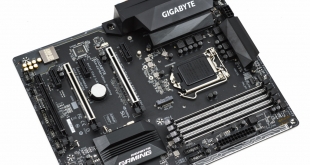
The Gigabyte Ultra Gaming motherboard is a fairly new model which was first released for the Z170 chipset shortly after Computex 2016. Only half a year later and Gigabyte has released a Z270 variant of the Ultra Gaming, the Z270X-Ultra Gaming, to coincide with the launch of Intel's new Kaby Lake platform and CPUs.
You can read our Kaby Lake Core i5-7600K and Core i7-7700K review HERE.

The emphasis of the Z270X-Ultra Gaming is still on the PC gaming audience but this time Gigabyte has rethought some of the hardware features and functionality to deliver a motherboard that meets more gaming motherboard criteria than before.
In a market that is transitioning to RGB lighting being the norm the Z270X-Ultra Gaming is now an RGB-ready product, unlike its predecessor which had red LEDs only. Gigabyte has also upped its game on the audio side of things by implementing the latest Realtek ALC 1220 codec, compared to the relatively archaic ALC 892 found on the Z170 version.
The changes continue with redesigned heatsinks for both the PCH and CPU VRMs, and a new rear plastic shroud. The rear I/O connections have been altered slightly with the two mini DisplayPort connections being replaced by a DVI-D port. Gigabyte has ditched the Intel Thunderbolt 3 controller found on the Z170 model, which was provided over the USB Type-C port, and replaced it with the ASMedia ASM2142 controller.
The Z270X-Ultra Gaming is being positioned between the Gigabyte Z270X-Gaming K3 and Z270X-Gaming K5 with a price point estimated to be around £160. As such the Z270X-Ultra Gaming will compete in the most competitive price segment of the market alongside other cost-competitive models from rival vendors, many of which KitGuru will be reviewing over the coming months.
| Gigabyte Z270X-Ultra Gaming | |
| CPU Socket | LGA 1151, 7 phase VRM |
| Chipset | Intel Z270 |
| Memory | DDR4, 4 DIMMs, up to 64GB and 3866MHz+ with OC |
| Onboard Graphics | Intel HD Graphics (supported CPUs), up to 1024MB of video memory |
| Discrete Graphics | Up to Nvidia 2-way/Quad SLI, AMD 3-way/Quad CrossFireX |
| Expansion Slots | 2 x PCIe 3.0 x16 (x16/x0 or x8/x8, from CPU) 1 x PCIe 3.0 x16* (x4 electrical, from PCH) 3 x PCIe 3.0 x1 (from PCH) *Shares bandwidth with PCIe x1_2 and PCIe x1_3, operates at 1X when either is populated. |
| Storage | 6 x SATA III 2 x SATA Express (shared with four SATA ports) 1 x M.2 1 x U.2 |
| USB | 6 x USB 2.0 (2 Rear, 4 Front, via PCH) 8 x USB 3.0 (4 Rear, 4 Front, via PCH) 2 x USB 3.1 (2 Rear [Type-A and C], via ASM2142) |
| Networking | Intel I219-V Gigabit LAN |
| Audio | Realtek ALC 1220, 7.1 Channel |
| Fan Headers | 5, all support 3/4 pin fans (2 x CPU, 1 x SYS_PUMP, 2 x SYS) |
| Rear I/O | 1 x PS/2 keyboard and mouse combo 1 x USB 3.1 Type-C 1 x USB 3.1 Type-A 1 x DVI-D 1 x HDMI 1.4b 4 x USB 3.0 2 x USB 2.0 1 x Gigabit LAN RJ45 1 x Optical S/PDIF out 5 x Audio Jacks |
| UEFI | UEFI AMI, DualBIOS, 2 x 64Mbit flash |
 KitGuru KitGuru.net – Tech News | Hardware News | Hardware Reviews | IOS | Mobile | Gaming | Graphics Cards
KitGuru KitGuru.net – Tech News | Hardware News | Hardware Reviews | IOS | Mobile | Gaming | Graphics Cards



I think I’m over with all these hardwares. The customer service is rubbish left, right, up and down, vendors and manufacture alike, MSI, Samsung the list goes on… I lost a M.2 screw, and MSI’s support could care less.
Hello Ryan
I’ve just bought this board for my new build. Do you think there’s a way to make the auto voltage function less aggressive?
Thanks 🙂
Hey, you could apply a core voltage offset. I discussed it at the bottom of the UEFI page. I found that -0.1 was enough to keep power down and was still perfectly stable. You may be able to get a lower voltage yourself (-0.1 to -0.2) depending on your CPUs capability. You could also choose a lower LLC setting instead of the Auto LLC setting. The core voltage offset is under MIT-CPU Core Voltage Control, if you leave the core voltage as auto then do the dynamic vcore option (use + and – on the keyboard to get down to -0.1, it’s a bit fiddly). MIT-Advanced Power Options has the LLC setting. Medium or lower should keep the voltage a bit less aggressive but the offset will be the most effective way.
Gigabyte may well alter the voltage behaviour with BIOS updates too so keep an eye out! Also be sure to have the “balanced” windows power profile to get adequate clocking/voltage down for less intensive tasks.
Alright, thanks for the tips!
I’ll make sure to look out for future updates.
The correct screw size is 2.0 x 3mm (CM2x3-3.3)
should be available at hardware / electronics stores.
Thanks for the suggestion, I’ve gone to two electronics stores specialising in screws, nuts and bolts, none of them has anything remotely as small as the M.2 screws. Hope, some manufacturers in computers parts will make them for sale in the future.
Isn’t that audio test pretty seriously flawed? If you do loop back the results are only as good as the line in ADC is and doesn’t really tell anything about the line out DAC quality. Judging by Realtek ALC1220 specs it has much worse line in than line out quality.
Can i run my I7 6700K on this Board?
yes
I see the F4 Bios has ‘V-Core Voltage Adjust’ has anyone used this and did it correct the high auto voltage issue?
Really? This board gets a 8 / 10 when by the picture it looks like it has a craptacular 7 phases? Combine that with the UEFI layout issues, bad auto voltages and thats plenty to bring it down to a 7 / 10.
Stop kissing Gigabytes arse and rate things accordingly.
eu preciso aprender a configurar a memoria g.skil 3200mhz nessa placa. alguem pode me ajudar?
does this motherboard support NVME?
its about what’s said in the reviews, not about the ratings themselves.
the Written Reviews tell you a lot more then just some arbitrary subjective-rating.
an 8/10, 7/10 and even a 6/10 could have a lot different meanings and interpretations base on the person. Some people may not view a 8/10 not that highly while a 6/10 might be seen as a ‘good’ score, to some.
It’s all based on the person perception of the numbers. You can’t objectively score a product like a video-game for example.
That’s why its important to read the ACTUAL review, rather then just look at the Rating/awards given to it. To see what is actually said about the product and make an informed decision based on that, rather then trying to make a decision based off an arbitrary rating.
Fallout New Vegas for example got a 84 on metacritic, though in my opinion its one of best games of that year, even now in my opinion it still holds up quite well as a great game. That said, it got an 84 out of 100 for a score. Does Scoring really matter? It’s meant to give a generic-overall view of the game in simple terms. like “Great Game” or “Great Product”.
7/10, 10/10, 1/10, etc doesn’t matter. What matters is the content of the review, what they say about the product itself, how it runs, it feels, how it looks, features, how it compares to other products in its industry, etc. Don’t take the 8/10 to heart, too much just because you feel the score should be different. Numbers mean different things to different people, so an 8 is not always the “8” the way you may be perceiving it.
Yes, but will depend on how many PCIE lanes you are using and your CPU.
If i enter a value of 1-1.299 it will work and when i put 1.35 for example it switches the mode to AUTO and locks at 1.3
On page 10 of the first guide he specifies how he has a profile with 1.35 voltage and on the second link there are screenshots of him at 1.375
https://view.joomag.com/gigabyte-z270-overclocking-guide-gigabyte-200-series-overclocking-guide/0767815001483933769
http://www.kitguru.net/components/motherboard/ryan-martin/gigabyte-z270x-ultra-gaming-motherboard-review/4/
Is it because I am on version f6 of the BIOS or is my mobo simply locked @ 1.3?
In the first guide he also mentioned how he set his CPU Vcore Loadline Calibration to TURBO and I don’t have this setting available
Z270P-D3 + i7-7700k BIOS version f6